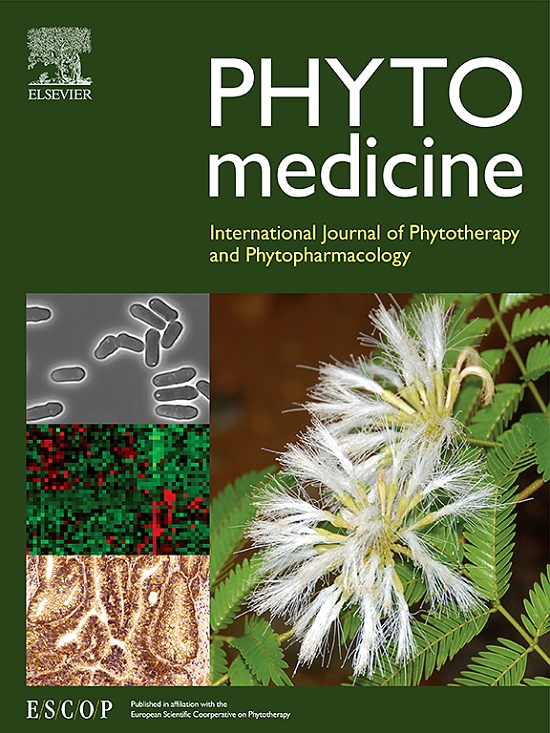4-Hydroxyderricin attenuates ischemic brain injury and neuroinflammation by upregulating haptoglobin expression in microglia
IF 6.7
1区 医学
Q1 CHEMISTRY, MEDICINAL
引用次数: 0
Abstract
Background
Angelica keiskei (Miq.) Koidz. is a traditional plant that is widely used in Asian countries because of its tonic, diuretic, and galactagogue properties. The chalcone compound 4-hydroxyderricin (4-HD), uniquely present in A. keiskei, has demonstrated inhibitory effects on inflammation in peripheral tissues. Nonetheless, its efficacy in central neuroinflammation and ischemic brain injury remains unclear.
Purpose
This study aims to assess the ability of 4-HD to alleviate acute ischemic brain injury and the associated inflammatory response, and to elucidate the underlying mechanisms.
Methods
Mice underwent middle cerebral artery occlusion (MCAO) surgery to induce acute cerebral ischemic injury. The extent of brain injury was evaluated by TTC staining and neurological function scoring. Immunofluorescence was employed to observe glial cell activation, whereas ELISA and RT-PCR were used to quantify inflammatory cytokine expression in ischemic brain tissues. Oxygen-glucose deprivation (OGD) and lipopolysaccharide (LPS) stimulation of BV2 microglial cells were conducted in vitro to examine the direct impact of 4-HD on microglial inflammation. ELISA and RT-PCR were carried out to quantify inflammatory cytokine expression in BV2 cells. Western blotting and immunofluorescence techniques were used to detect protein expression and localization, respectively. Additionally, alterations in gene expression were measured using RNA-seq analysis profiling following 4-HD treatment of BV2 cells. A short hairpin RNA (shRNA) was used to silence the Haptoglobin (Hp) gene to elucidate the relationship between drug effects and Hp protein levels.
Results
4-HD effectively reduced the infarct area and enhanced neurological function 24 h post-MCAO surgery by lowering inflammatory cytokine levels and inhibiting microglia activation in ischemic brain tissues. In OGD and LPS-stimulated BV2 microglia, 4-HD decreased the levels of inflammatory cytokines. Mechanistic research indicated that 4-HD enhanced Hp and reduced HMGB1 expression in BV2 cells. Moreover, the activation of the NF-κB and MAPK signaling pathways, two key pro-inflammatory pathways downstream of HMGB1, was inhibited by 4-HD treatment. In BV2 cells with Hp gene knockdown, the inhibitory effect of HMGB1 disappeared, and its anti-inflammatory effect was also significantly weakened.
Conclusion
4-HD has the potential to mitigate brain injury and neuroinflammation resulting from MCAO-induced acute ischemic damage. This neuroprotective effect is linked to the suppression of microglial activation and the inhibition of HMGB1 pro-inflammatory signaling, facilitated by the increased expression of the Hp protein. This study revealed, for the first time, the protective effects and mechanisms of 4-HD on ischemic brain injury. Additionally, we present the Hp protein as a new target for a small-molecule compound to protect against ischemic brain injury, offering a novel strategy for developing new neuroprotective drugs.

求助全文
约1分钟内获得全文
求助全文
来源期刊

Phytomedicine
医学-药学
CiteScore
10.30
自引率
5.10%
发文量
670
审稿时长
91 days
期刊介绍:
Phytomedicine is a therapy-oriented journal that publishes innovative studies on the efficacy, safety, quality, and mechanisms of action of specified plant extracts, phytopharmaceuticals, and their isolated constituents. This includes clinical, pharmacological, pharmacokinetic, and toxicological studies of herbal medicinal products, preparations, and purified compounds with defined and consistent quality, ensuring reproducible pharmacological activity. Founded in 1994, Phytomedicine aims to focus and stimulate research in this field and establish internationally accepted scientific standards for pharmacological studies, proof of clinical efficacy, and safety of phytomedicines.
 求助内容:
求助内容: 应助结果提醒方式:
应助结果提醒方式:


